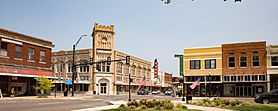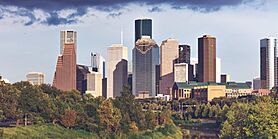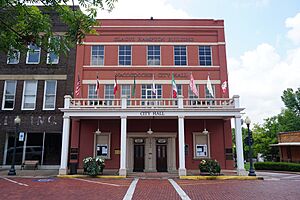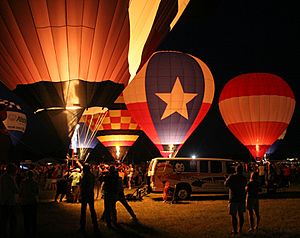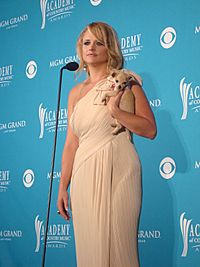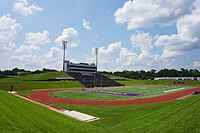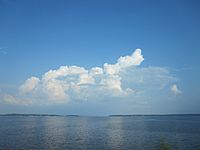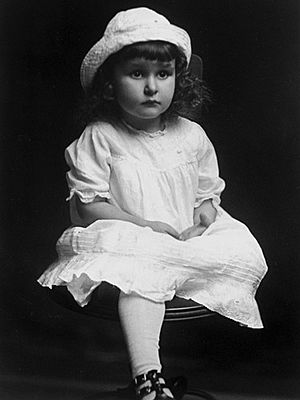East Texas facts for kids
Quick facts for kids
East Texas
|
|
|---|---|
|
From top, left to right: Downtown Tyler; Downtown Longview; Paris Commercial Historic District; Downtown Nacogdoches; Downtown Beaumont and Downtown Houston
|
|
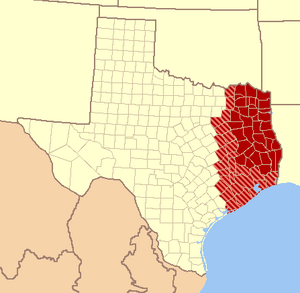
East Texas counties in red; the inclusion of pink and red counties varies from source to source, thus may or may not be included in East Texas
|
|
| Country | |
| State | |
| Largest city | Houston |
| Population
(2020)
|
|
| • Total | 8,814,548 |
East Texas is a special area in the eastern part of the U.S. state of Texas. It's known for its unique culture, geography, and natural environment. This region includes most of 41 counties and is often split into Northeast and Southeast Texas. Much of East Texas is covered by the Piney Woods ecoregion, which means it has lots of pine trees.
Sometimes, East Texas is defined only as the Piney Woods area. As you move towards Central Texas, the forests become less dense and eventually turn into open plains. The Handbook of Texas describes East Texas as being separated from the rest of the state by a line from the Red River in Lamar County down to Galveston Bay.
A simpler way to think about East Texas is the area between the Trinity River (west), the Louisiana border (east), the Gulf of Mexico (south), and the Oklahoma border (north). Arkansas is also to the northeast. Important cities in East Texas include Tyler, Longview, Texarkana, Lufkin, Marshall, Palestine, Henderson, Jacksonville, Mount Pleasant, and Nacogdoches. Some broader definitions also include the big cities of Houston and Beaumont.
Contents
East Texas: A Unique Region
Exploring East Texas Geography

The weather is a key feature of East Texas. The entire region has a humid subtropical climate, which means it's usually warm and humid, like the rest of the Southeast U.S. Cold air from the north can sometimes bring cooler temperatures. East Texas gets more rain than other parts of Texas, usually between 35 to 60 inches (890 to 1,520 mm) each year. For example, in Houston, the average temperature in January is about 50.4°F (10.2°C), and in July, it's about 82.6°F (28.1°C). Houston's winters are a bit warmer because it's closer to the coast and further south.
All of East Texas is part of the Gulf Coastal Plain. The local plants change from north to south. The southern third has temperate grassland, while the northern two-thirds are covered by the Piney Woods, a temperate forest. These woods cover more than 23,500 square miles (60,860 km2) and are part of a larger forest that extends into Louisiana, Arkansas, and Oklahoma. West of the Piney Woods, you'll find ranchlands and oak forests.
The main rivers in East Texas are the Sabine, Trinity, Neches, Angelina, and Sulphur. The Brazos and Red rivers also flow through the region. The Red River forms the northern border with Oklahoma and part of Arkansas. In East Texas, small rivers and creeks often flow into swampy areas called bayous, where they mix with the surrounding forest. Bald cypress trees and Spanish moss are common plants in these bayous. Famous bayous include Cypress Bayou and Buffalo Bayou.
Deep East Texas: A Special Area
Deep East Texas is a smaller part of East Texas, along with Northeast and Southeast Texas. The Deep East Texas Council of Governments says this area includes twelve counties: Angelina, Houston, Jasper, Nacogdoches, Newton, Polk, Sabine, San Augustine, San Jacinto, Shelby, Trinity, and Tyler.
The name "Deep" comes from its location, which is further south and closer to the Gulf Coast than the rest of East Texas. It also refers to the area's culture and landscape, which are very similar to East Texas, with lots of forests.
"Deep" also describes the unique culture of the area. It's sometimes called the "Big Thicket" because of the very dense underbrush in the Piney Woods. This was one of the first parts of Texas settled by Anglo-Americans from the United States. It was also one of the last areas where governments (like those of New Spain, Mexico, the Republic of Texas, or the United States) could fully enforce laws.
This area has two of the oldest towns in Texas: Nacogdoches, which dates back to the 1700s, and San Augustine, the oldest "British-American" settlement from the 1820s. Many people in this region have English, Scottish, Scots-Irish, and Welsh backgrounds because of how it was settled. This is different from West Texas and South Central Texas, where many people have Hispanic or German roots.
The Spanish and later Mexican governments didn't want settlers from the United States until Mexico became independent. East Texas was not heavily settled by Spanish or Mexican colonists. So, the government allowed people from the U.S. to move in to help defend against raids by the Apache and Comanche tribes. Because these governments couldn't control the area well, the "Big Thicket" became a hiding place for people seeking refuge.
The "Pine Curtain" Mystery
Because the region was isolated for a long time and has strong ties to the Deep South, the piney woods are sometimes called a 'curtain'. This "Pine Curtain" suggests a unique cultural area that sets East Texas apart from the rest of the state. People who used to live there sometimes say living behind the 'Pine Curtain' felt like an escape. This phrase is often used to describe the area and has appeared in newspapers and tourist guides.
Who Lives in East Texas?
East Texas includes 41 counties. Most of these counties work together in regional groups like the Ark-Tex Council of Governments and the East Texas Council of Governments.
Counties usually included are Anderson, Angelina, Bowie, Camp, Cass, Cherokee, Delta, Franklin, Gregg, Hardin, Harrison, Henderson, Hopkins, Houston, Jasper, Jefferson, Lamar, Marion, Morris, Nacogdoches, Newton, Orange, Panola, Polk, Rains, Red River, Rusk, Sabine, San Augustine, San Jacinto, Shelby, Smith, Titus, Trinity, Tyler, Upshur, Van Zandt, and Wood County, Texas. Sometimes, Harris County and the Greater Houston metropolitan area are also included, especially when talking about Southeast Texas.
Three other East Texas counties that work with different regional councils are Chambers County (Anahuac), Liberty County (Liberty), and Walker County (Huntsville). These are all close to the Houston area.
Outside of the Houston area, the population isn't very dense, usually between 18 to 45 people per square mile (7 to 12 per km2). In the Big Thicket area, it's even less. East Texas has a large total population, with many people living in the Golden Triangle (Texas) cities of Beaumont, Port Arthur, and Orange in Southeast Texas. Moving north, Lufkin and Nacogdoches are important cities in Deep East Texas. Further north, Tyler, Longview, and Marshall in Northeast Texas, along with Texarkana on the border with Arkansas, are major population centers. Shreveport, Louisiana, which is just eight miles from the Texas border, is a key economic and cultural hub for the Ark-La-Tex region (where Arkansas, Louisiana, and East Texas meet).
In 2010, these 41 East Texas counties had over 2 million residents, which was about 8% of Texas's total population.
Based on 2023 estimates, the five counties with the most people were:
- Jefferson County (251,496)
- Smith County (245,209)
- Gregg County (126,243)
- Bowie County (91,687)
- Angelina County (87,319)
In 2022, the ten most populated cities in East Texas (outside of Houston's metro area) were:
- Beaumont (112,089)
- Tyler (109,286)
- Longview (82,531)
- Port Arthur (55,479)
- Huntsville (47,351)
- Texarkana (35,778) (Texas side only)
- Lufkin (34,152)
- Nacogdoches (31,990)
- Paris (24,695)
- Marshall (23,641)
In 2010, the population of East Texas counties was about 65.93% non-Hispanic white, 17.44% African American, and 14.29% Hispanic or Latino American. East Texas is part of the Black Belt region, which was a center for cotton farming and had a large enslaved African-American population. Because of this history, East Texas has the largest Black population in the state.
The Culture of East Texas


East Texas is often seen as the western edge of the Deep South. Its culture is mainly shaped by the customs and traditions of European American and African American Southerners who settled there in the mid-to-late 1800s. African Americans were first brought to the area to work on plantations. Harrison County had many plantations and a large number of enslaved people before the Civil War.
The way people speak in East Texas often has a Southern English accent, similar to the "drawl" heard in the Lower South. Other parts of Texas might have a different accent, sometimes with influences from Hispanic or Midwestern speech.
East Texas doesn't have as much influence from European immigrants who arrived in the late 1800s and early 1900s, unlike some other parts of Texas. Also, newer waves of immigrants from places like India, other Asian countries, and Latin America have had less impact here compared to other Texas regions.
Most East Texans are Protestant Christians and are part of the Bible Belt. Many different Christian groups are present, including Baptists (like the Southern Baptist Convention and National Baptist Convention USA), Methodists, Presbyterians, Lutherans, and Pentecostals. Roman Catholicism is also important, especially with more Hispanic or Latino Americans moving to the area. The largest Catholic areas are the Roman Catholic Archdiocese of Galveston-Houston in Southeast Texas and the Roman Catholic Diocese of Tyler in the northeast. Other faiths like Mormonism and Judaism also have followers in East Texas.
Many people of Cajun and Creole background have moved from Louisiana. While some have kept their original culture, many have adopted the local East Texas culture. This often included changing from Roman Catholicism to Protestant churches. Even though people tend to blend in, Cajun and Creole foods like jambalaya and catfish gumbo are very popular in the region. Many East Texans, even without Louisiana roots, are good at making these dishes.
While some East Texans connect with cowboy culture, most identify more with small-scale farming, similar to the Southern U.S., rather than the large cattle ranching of Texas's plains. However, East Texans do commonly own and trade cattle, with "sale barns" holding weekly and monthly trades.
In northern East Texas, the ancient Caddo Mississippian culture is still important. Cherokee County is home to the Caddo Mounds State Historic Site. You can also see the "Caddo Indian Collection" at the Gregg County Historical Museum in Longview. In the mid-1800s, East Texas cities like Marshall and Jefferson were very influential. Many East Texans have a mix of European and Native American family history, like country artists Miranda Lambert and Kacey Musgraves. The Museum of East Texas opened in Lufkin in 1976.
Music from East Texas
East Texas is home to the Texas Country Music Hall of Fame in Carthage. People in East Texas enjoy many types of music, including gospel, bluegrass, blues, rock, country, soul, rhythm and blues, and Cajun. Texas blues started in East Texas, and many famous blues musicians like Lightnin' Hopkins and T-Bone Walker were born here. East Texans love live music at local fairs and festivals, such as the Texas Rose Festival in Tyler, the East Texas Yamboree in Gilmer, and Longview's Great Texas Balloon Race.
Many famous musicians have roots in East Texas, including: George Jones (Saratoga), Miranda Lambert (Lindale), Kacey Musgraves (Mineola), Jamie Foxx, (Terrell), Neal McCoy (Longview and Jacksonville), Lee Ann Womack (Jacksonville), Janis Joplin (Port Arthur), UGK (Port Arthur), Don Henley (Linden), Ray Price (Perryville), Johnny Horton (Rusk), Johnny Mathis (Gilmer), Tex Ritter (Panola County), Jim Reeves (Panola County), Mark Chesnutt (Beaumont), Tracy Byrd (Vidor), Clay Walker (Beaumont), T-Bone Walker (Linden), Chris Tomlin (Grand Saline), and Michelle Shocked (Gilmer).
The famous pianist Van Cliburn, who was born in nearby Shreveport, Louisiana, grew up in Kilgore. Kilgore College has the Van Cliburn Auditorium on its campus. Many high school bands in East Texas still perform in a military marching style, which is different from other parts of the state. These bands compete in the National Association Of Military Marching Bands.
Sports and Outdoor Fun
Just like in other parts of Texas, high school football is the most popular local sport in East Texas. People from towns and rural areas fill high school stadiums to cheer for their local teams, cheerleaders, and bands. Many East Texas high school teams have won state championships and produced many college and professional football players.
Earl Campbell, known as the "Tyler Rose," played football for John Tyler High in Tyler before playing for the Texas Longhorns and the Houston Oilers. Don Meredith, a famous player for the Dallas Cowboys, played at Mt. Vernon. Dez Bryant, a football player from Lufkin, played wide receiver for the Dallas Cowboys. Adrian Peterson, a star running back, played high school football in Palestine. Other popular high school sports in East Texas include basketball, baseball, volleyball, softball, and track.
Many young people in East Texas play Little League Baseball, soccer, and softball. Church leagues often offer basketball and softball for both kids and adults. Recently, "cowboy churches" have become more common and offer rodeo events for young people.
East Texans also enjoy college sports. Most residents support college teams from other parts of the state, like the Texas A&M Aggies, Texas Longhorns, Texas Tech Red Raiders, Baylor Bears, and TCU Horned Frogs. If you include Houston, the Houston Cougars are another well-known college team. Because East Texas is close to neighboring states, many fans also support the LSU Tigers, Arkansas Razorbacks, Oklahoma State Cowboys, and Oklahoma Sooners. The Battle of the Piney Woods is a big sports rivalry between the Bearkats from Sam Houston State University in Huntsville and the Lumberjacks from Stephen F. Austin State University (SFA) in Nacogdoches.
Other universities and colleges with sports teams in East Texas include East Texas Baptist University Tigers in Marshall, University of Texas at Tyler Patriots in Tyler, and LeTourneau University Yellowjackets in Longview. There are also several junior colleges that play in the Southwest Junior College Conference. East Texas is also home to the Kilgore College Rangerettes, a world-famous dance team that started in 1939.
A few professional sports teams are in East Texas. The East Texas Pump Jacks in Kilgore play baseball in the Texas Collegiate League. The East Texas Storm, a semiprofessional football team in Tyler, plays in the Lone Star Minor League. Generally, people in northern East Texas support professional teams from the Dallas/Fort Worth area (Dallas Cowboys, Dallas Mavericks, Texas Rangers, Dallas Stars, FC Dallas). Those in southern East Texas tend to support teams from the Houston area (Houston Texans, Houston Rockets, Houston Astros, Houston Dynamo FC).
Other popular sports in East Texas include rodeo (including PRCA events), hunting, and fishing. Big rodeos are held in cities like Beaumont, Nacogdoches, Paris, Longview, Gladewater, Huntsville, Lufkin, Athens, Palestine, and Lindale. East Texas has many great lakes for fishing, such as Toledo Bend Reservoir, Lake Sam Rayburn, Lake Livingston, Lake Fork Reservoir, and Lake Tawakoni.
East Texas also has many golf courses and golf fans, as well as NASCAR fans. However, the region doesn't host professional events for these sports. The closest NASCAR track is Texas Motor Speedway in Fort Worth.
East Texans enjoy many Texas state parks, including Caddo Lake, Atlanta, Daingerfield, Lake Bob Sandlin, Tyler, Mission Tejas in Grapeland, Cooper Lake, Lake Tawakoni, Martin Creek, Huntsville, Lake Sam Rayburn, Lake Livingston, and Sea Rim. East Texas is also home to several national forests and preserves, such as the Angelina National Forest, Davy Crockett National Forest, Sam Houston National Forest, Sabine National Forest, Big Thicket National Preserve, Trinity River National Wildlife Refuge, Anahuac National Wildlife Refuge, and McFaddin National Wildlife Refuge.
How East Texas Makes a Living

Industries and Jobs
Historically, the economy of East Texas has relied on lumber, cotton, cattle, and oil. Before the discovery of the East Texas Oil Field, cotton farming, logging, and cattle ranching were the main ways people earned a living. The needs of local farmers helped create towns and trading posts. Like in many places, the routes of railroads often decided which towns would grow and which would fade. In the early 1900s, oil was discovered, which completely changed the region's future.
In recent decades, oil production in the East Texas Oil Field, which is the largest oil field in the United States, has decreased a bit. This also meant fewer high-paying jobs for workers without advanced education. Over the 1900s, local shops and cafes were replaced by larger department stores, retail chains, and fast-food restaurants. As oil production went down, some small towns saw cafes and gas stations close. In 2022, East Texas was noted for its economy becoming more diverse, especially in Deep East Texas, as oil became less dominant. The region has also become a popular place for companies that own patents, because its legal system is known to be favorable to patent holders. In 2009, it was even said that natural gas had become more important than crude oil in East Texas.
Tourism hasn't been a huge part of the economy for most of East Texas. However, several busy highways pass through the region, which has helped businesses grow along those routes. These include Interstate 30 (from Dallas to Texarkana), Interstate 20 (through Dallas and to Shreveport), Interstate 10 (through Houston and Beaumont into Louisiana), Interstate 45 (from Houston to Dallas), and U.S. Highway 59 (through Houston and north past Texarkana, which is being upgraded to Interstate 69).
Economic Challenges and Support
East Texas faces some economic challenges. In 2021, the poverty rate in the greater northeast Texas area was 16%, which was higher than the state rate of 14.7% and the national rate of 13.4%. In the same year, 13.4% of households received Food Stamps or SNAP benefits, compared to 11.8% across Texas. As of January 2022, the average wage in the region was $45,027, which was lower than the state average of $62,289 and the national average of $64,555.
Famous People from East Texas
- Sandy Duncan, actor, from Henderson and Tyler
- George Foreman, former professional boxer, from Marshall
- Jamie Foxx, actor and comedian, from Terrell
- Sam Houston, former president of the Republic of Texas and governor of Texas, lived in Huntsville
- Lady Bird Johnson, former First Lady of the United States, born in Karnack
- Joe R. Lansdale, award-winning author, born in Gladewater
- Richard Linklater, film-maker, from Huntsville
- Margo Martindale, award-winning actor, from Jacksonville
- Matthew McConaughey, actor, from Longview
- Lonnie "Bo" Pilgrim, founder of Pilgrim's Pride Chicken, from Pittsburg
- Ross Perot, businessman and former U.S. presidential candidate, born in Texarkana
- Adrian Peterson, former NFL running back, from Palestine
- Tye Sheridan, actor, from Elkhart
- Carroll Shelby, famous car designer (Shelby Cobra), from Leesburg
- Sissy Spacek, actor, from Quitman
- William B. Travis, famous commander at the Alamo, lived in Anahuac
- Forest Whitaker, actor, from Longview
- J.D. Spears, composer for League of Legends, from Frankston
- Former United States Senators:
- Horace Chilton born near Tyler
- Charles Allen Culberson lived in Gilmer and Jefferson
- James W. Flanagan lived in Henderson
- Samuel B. Maxey lived and practiced law in Paris
- John Henninger Reagan practiced law in Palestine and Henderson County
- Thomas Jefferson Rusk lived in Nacogdoches and was a Chief Justice of the Supreme Court of the Republic of Texas
- Morris Sheppard born in Morris County
- Matthias Ward lived in Clarksville and Jefferson
- Louis Wigfall lived in Nacogdoches and Marshall
- Ralph Yarborough born in Chandler
- Other former governors of Texas:
- Thomas Mitchell Campbell, born in Rusk
- Oscar Branch Colquitt, newspaper owner in Pittsburg and Morris County
- Price Daniel, born in Dayton
- James Pinckney Henderson, first governor of Texas, practiced law in San Augustine
- William P. Hobby, born in Moscow
- Jim Hogg, born in Rusk
- Richard B. Hubbard, lived in Tyler and Lindale
- Allan Shivers, born in Lufkin
- Ross S. Sterling, born in Anahuac
- Mark White, born in Henderson
- George Tyler Wood, second governor of Texas, lived near Point Blank




